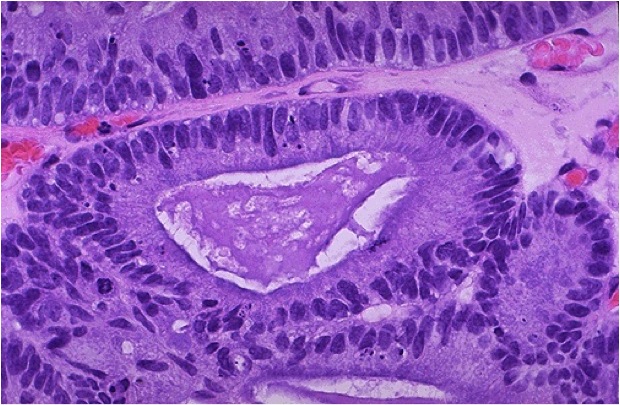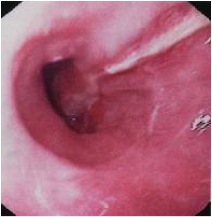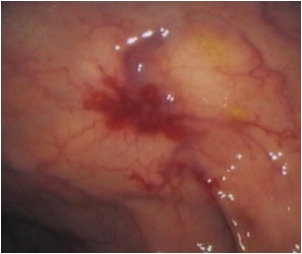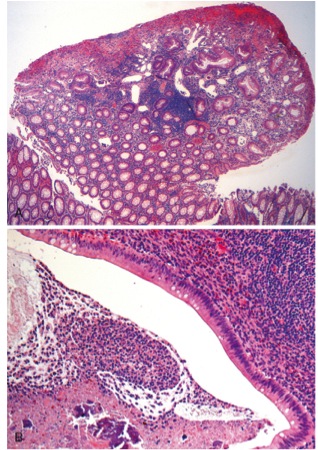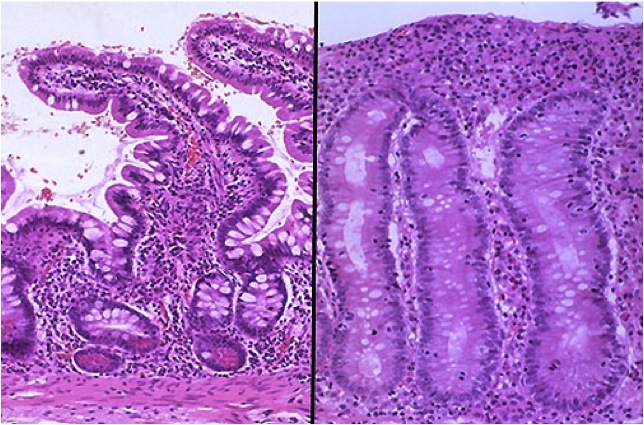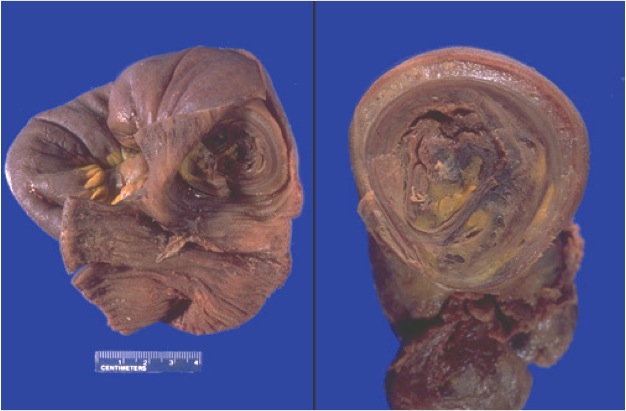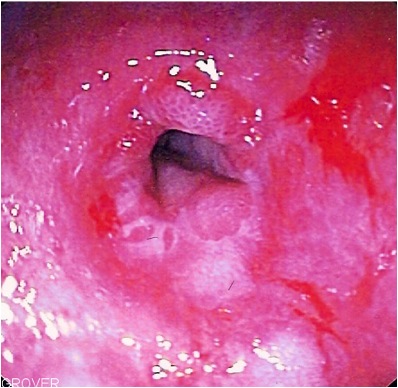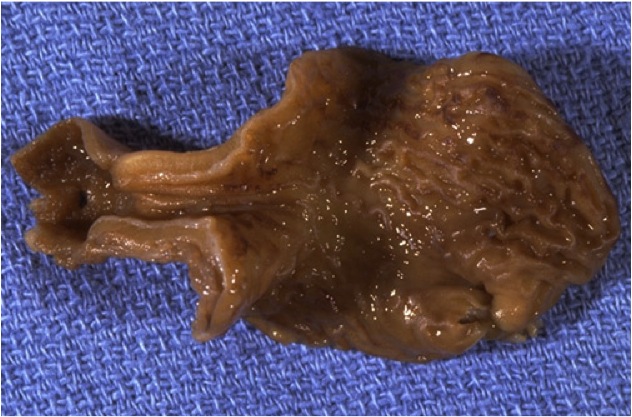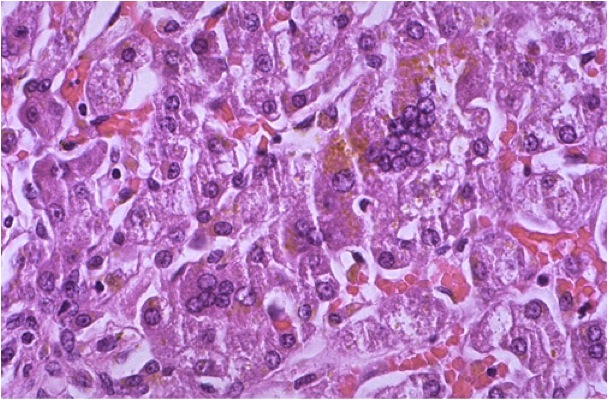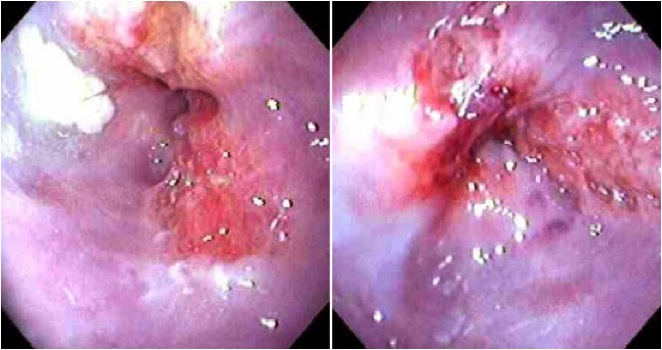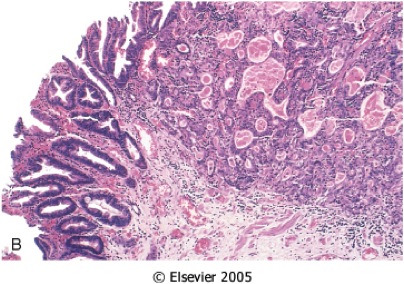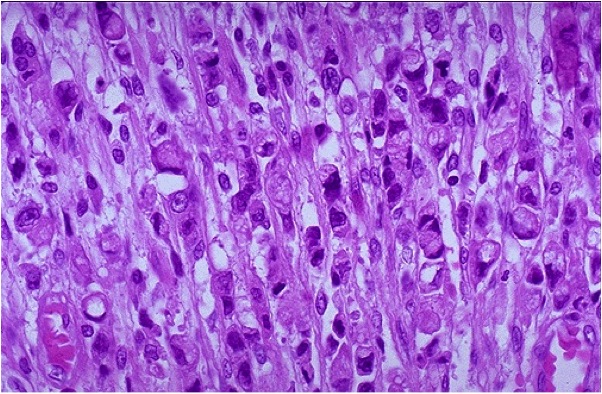Gastrointestinal Hardest Practice Exam! Trivia Quiz
(1).png)
Do you know anything about the gastrointestinal system? Do you think you could pass this exam? Common gastrointestinal disorders include constipation, irritable bowel syndrome, hemorrhoids, fissures, infections, diverticular disease, colitis, colon polyps, and cancer. And this is to name a few. There is a wide array of gastrointestinal problems that are not as common but do exist. Take this exam and see how much you know about the gastrointestinal system.
- 1.
In Barrett's esophagus, which of the following cell types are seen above the Z-line?
- A.
Stratified squamous only
- B.
Stratified squamous and simple columnar
- C.
Simple columnar only
- D.
Simple columnar and pseudostratified ciliated columnar
Correct Answer
B. Stratified squamous and simple columnarExplanation
Barrett's esophagus describes a change in the squamous epithelium of the esophagus to intestinal-type epithelium with metaplasia on biopsy.Rate this question:
-
- 2.
Which of the following is correct regarding the contents of the layers of the alimentary canal?
- A.
The mucosal layer contains all of the smooth muscle
- B.
Meissner's plexus is located in the muscularis externa
- C.
Retroperitoneal organs are defined as having serosa
- D.
Auerbach's plexus is located in the muscularis externa
- E.
Auerbach's plexus is located in the mucosa
Correct Answer
D. Auerbach's plexus is located in the muscularis externaExplanation
Auerbach's plexus is located between the inner and outer layers of SM in the muscularis externa.Rate this question:
-
- 3.
A 4 month old infant present with bilious vomiting and abdominal distention. X-ray shows What is the mechanism behind this patient's disease?
- A.
Exposure to teratogens results in the loss of contractile ability of the smooth muscle cells
- B.
Gestational diabetes leads to a neuropathy causing the inability to relax the smooth muscle segement
- C.
The absence of intramural ganglion cells causes uncoordinated movement of the bowel segment, leading to obstruction
- D.
Release of excess neurotransmitters results in the dyskinetic movement of the bowel segment
Correct Answer
C. The absence of intramural ganglion cells causes uncoordinated movement of the bowel segment, leading to obstructionExplanation
This is Hirschsprung disease, this congenital condition almost always presents in infants as an obstruction. It is caused by a lack of ganglionic cells in a bowel segment. This causes that area to be tonically closed, leading to obstruction.Rate this question:
-
- 4.
Which of these is not part of the functional lower esophageal sphincter?
- A.
Smooth muscle
- B.
Skeletal muscle
- C.
Diapraghm
- D.
Costal cartilage
- E.
None (all of the above are part of the LES)
Correct Answer
D. Costal cartilageExplanation
The 'intrinsic' part of the sphincter includes the SMC's, while the 'external'includes the skeletal muscle and crural part of the diaphragm.Rate this question:
-
- 5.
Which of these statements is/are true regarding the enzyme lactase?
- A.
It is found in the brush border
- B.
Deficiency is common in the elderly (defined as older than the dean of your medical school)
- C.
Many experts don't consider lactase deficiency to be a disease because it is so common in otherwise healthy adults
- D.
All of the above
- E.
None of the above
Correct Answer
A. It is found in the brush borderExplanation
Lactase is an enzyme crucial for the digestion of lactose, a sugar found in dairy products. It is primarily located in the brush border of the small intestine, where it facilitates the breakdown of lactose into absorbable sugars. Contrary to the notion that lactase deficiency is associated with age, it is not strictly defined by age criteria. While a decrease in lactase activity can occur with age, lactase deficiency can affect individuals at any age. As for the claim that many experts do not consider lactase deficiency a disease due to its prevalence in healthy adults, it's important to note that lactase deficiency can lead to lactose intolerance, causing digestive discomfort in those affected. Therefore, recognizing lactase deficiency as a condition is essential for understanding and managing its impact on individuals' ability to digest lactose-containing foods.Rate this question:
-
- 6.
Which phase is the least common cause of dysphagia in the elderly?
- A.
Preparatory
- B.
Oral
- C.
Pharyngeal
- D.
Esophageal
Correct Answer
D. EsophagealExplanation
Mentioned in the Geriatric GI lecture that A, B, and C are the most common.Rate this question:
-
- 7.
A 20-year-old man presents with 1 episode of hematochezia. He is concerned because his mother died of colorectal cancer at 50 years of age. He has no further information about his family history. He undergoes colonoscopy and is found to have 20 adenomas ranging in size from 4 to 15 mm. On further exam and testing, he is found to have with supernumerary teeth, osteomas, epidermoid cysts and lipomas.What is the most likely diagnosis?
- A.
Turcot syndrome
- B.
FAP
- C.
HNPCC
- D.
Gardner's syndrome
- E.
Juvenile polyposis
Correct Answer
D. Gardner's syndromeExplanation
This is Gardner's syndrome, which is a familial polyposis that presents with extra-intestinal manifestations including extra-intestinal manifestations including epidermal inclusion cysts, osteomas, desmoid tumors, and dental abnormalities.
Turcot syndrome is associated with CNS tumors.
FAP is the broader term that this falls under, but because of the smaller number of polyps (Rate this question:
-
- 8.
Which of the following statements is true regarding the genetics of colon cancer?
- A.
P53 inactivation is a critical early step in the APC pathway of colon cancer
- B.
Mismatch repair genes play a key role in the APC pathway
- C.
SMAD2 and SMAD4 loss on 18q21 is a late factor in the APC pathway
- D.
The first hit in the HNPCC pathway consists of change in function of E-cadherin or B-catenin
- E.
The HNPCC pathway is the most common pathway of colon cancer development
Correct Answer
C. SMAD2 and SMAD4 loss on 18q21 is a late factor in the APC pathwayExplanation
-C is correct
-A is incorrect because P53 inactivation is a late step in FAP
-B is incorrect because that refers to the HNPCC pathway
-D is incorrect because that is the second hit in the FAP pathway
-E is incorrect because APC is the most common pathwayRate this question:
-
- 9.
(MULTIPLE ANSWER QUESTION)In this adenocarcinoma biopsy, which of the following are seen?
- A.
Hyperchromatism of nuclei
- B.
Normal goblet cells
- C.
Pleomorphism of nuclei
- D.
Neoplastic glands
Correct Answer(s)
A. Hyperchromatism of nuclei
C. Pleomorphism of nuclei
D. Neoplastic glandsExplanation
See the Colorectal cancer lecture if you don't recognize this image.Rate this question:
-
- 10.
Which of the following are symptoms of diverticulitis?
- A.
Nausea
- B.
Diarrhea
- C.
Pneumaturia
- D.
Leukocytosis
- E.
All of the above
Correct Answer
E. All of the aboveExplanation
All are correct
Leukocytosis is part of the 'triad' along with LLQ pain, and fever.
Diarrhea is a common presenting symptom, as is nausea.
Pneumaturia can result from a colovesical fistula from diverticulitis.Rate this question:
-
- 11.
A 55 year old man with a history of atrial fibrillation presents to your office 2 months post myocardial infarction. He has had sudden-onset, diffuse abdominal pain that began 18 hours ago. He has not been vomiting, but he has had several episodes of diarrhea, the last of which was bloody. What is the most likely mechanism behind his current symptoms?
- A.
Arterial embolism
- B.
Venous thrombosis
- C.
Arterial thrombosis
- D.
Nonocclusive ischemia
- E.
All of the above
Correct Answer
A. Arterial embolismExplanation
A is the best answer because it is the most common cause of acute mesenteric ischemia, and the patient has two risk factors for it: his recent MI and his atrial fibrillation
B is more common in hypercoagulable states or heart failure.
C is possible, but statistically less likely, and there is no proof in the vignette that he has PVD.
D is not likely because he is not in a low flow stateRate this question:
-
- 12.
A 40-year-old housewife complains of recurrent constipation. She has had problems since her 20s, but they are worse now. The constipation is accompanied by abdominal bloating and abdominal pain, and the discomfort is only better when she has a bowel movement. On her gynecologist's advice, she has tried more fiber in her diet, including fresh fruits and leafy vegetables, but that has only made the bloating worse. Her past history includes a cholecystectomy and a hysterectomy. Physical examination is entirely normal. Rectal examination reveals normal consistency stool. Stool samples test negative for occult blood. She denies anorexia, malnutrition, weight loss, or waking up at night in pain.What is the most likely diagnosis?
- A.
Ulcerative colitis
- B.
Crohn's disease
- C.
Celiac disease
- D.
Irritable bowel syndrome
- E.
Staph aureus infection
Correct Answer
D. Irritable bowel syndromeExplanation
This is most likely to be IBS at this point because of the long history of abdominal pain that gets better with BMs and normal exam results, along with the pertinent negative of weight loss.Rate this question:
-
- 13.
What is true about the mechanism of action of the IBS medications Alosetron and Tegaserod?
- A.
Alosetron and Tegaserod are both 5HT agonists
- B.
Alosetron and Tegaserod are both 5HT antagonists
- C.
Alosetron is a 5HT3 agonist and Tegaserod is a 5HT4 antagonist
- D.
Alosetron is a 5HT3 antagonist and Tegaserod is a 5HT4 agonist
Correct Answer
D. Alosetron is a 5HT3 antagonist and Tegaserod is a 5HT4 agonistExplanation
Alosetron is classified as a 5HT3 antagonist, which means it blocks the action of serotonin at the 5HT3 receptors. Tegaserod, on the other hand, is a 5HT4 agonist, which means it activates the 5HT4 receptors. This difference in mechanism of action suggests that Alosetron and Tegaserod have opposite effects on serotonin signaling in the body. Alosetron reduces the activity of serotonin, while Tegaserod enhances it.Rate this question:
-
- 14.
Which of the following metal ions has primarily a structural (as opposed to catalytic) role within the body?
- A.
Fe2+
- B.
Co2+
- C.
Mg2+
- D.
Mn2+
- E.
Ca2+
Correct Answer
E. Ca2+Explanation
Calcium (Ca2+) primarily has a structural role within the body. It is an essential mineral that is mainly found in bones and teeth, providing strength and rigidity to support the body. Calcium also plays a crucial role in muscle contraction, nerve function, and blood clotting. While other metal ions listed may have some structural roles or catalytic functions, calcium's primary function is structural.Rate this question:
-
- 15.
What is the role of Folic acid (B9) in amino acid metabolism and nucleotide synthesis?
- A.
Coenzyme for redox reactions
- B.
Catalyze aldehyde transfer rxns
- C.
Source of 1-Carbon fragments
- D.
Maintains activity of Fe2+-dependent hydroxylases
Correct Answer
C. Source of 1-Carbon fragmentsExplanation
A is what riboflavin does
B is what thiamine does
C is correct
D is what ascorbate doesRate this question:
-
- 16.
A 55-year-old male smoker is admitted with pneumonia. He lives alone and has been unemployed for several years, since being kicked out of medical school. He is receiving unemployment benefit but no additional social support. He is unkempt and thin, with a BMI of 19 kg/m^2. He shows signs of irritability, fatigue, headaches, and peripheral edema. The following day it is noted that the man is increasingly confused and requiring full nursing support as he is too unsteady to stand unaided. The ward doctor notes that he has nystagmus. High alcohol intake is queried, but no independent social history is available. The patient gradually improves but has continuing problems with his memory and appears to invent events to compensate for this. He remains unsteady on his feet and is found to have poor sensation in his lower limbs. The patient is judged no longer able to care for himself, and is admitted to a nursing home for long-term care.What vitamin deficiency is most likely here?
- A.
B1
- B.
B3
- C.
B6
- D.
B12
- E.
C
Correct Answer
A. B1Explanation
Keys here are the Wernicke-Korsakoff syndrome and the wasting, headaches, irritability, peripheral edema and peripheral nerve damage suggest dry beriberi.Rate this question:
-
- 17.
A medical student preparing to pull an all-nighter to prepare for the upcoming GI test decides to make the ultimate energy drink. He takes a 6 pack of 5 hour energy drinks (each containing 40 mg of B6), combines them in a beer stein, and adds 4 ground-up 100 mg B6 supplements to the mixture, then drinks it all in one sitting. Which of the following symptoms is he most likely to have as a result of his concoction?
- A.
Photosensitivity
- B.
Loss of position and vibratory sense (motor strength intact)
- C.
Loss of vibratory but not position sense
- D.
All of the above
- E.
A and B only
Correct Answer
E. A and B onlyExplanation
A and B are typical for B6 toxicity
C is more typical of B12 deficiency
I would also expect him to have some nausea, too.Rate this question:
-
- 18.
Which of these laxatives is hyperosmolar laxative?
- A.
Methylcellulose
- B.
Polycarbophil
- C.
Lactulose
- D.
Psyllium hydrophilic mucilloid
Correct Answer
C. LactuloseExplanation
Lactulose is a hyperosmolar laxative because it works by drawing water into the colon, which increases the water content of the stool and stimulates bowel movements. This helps to soften the stool and relieve constipation. Methylcellulose, polycarbophil, and psyllium hydrophilic mucilloid are all bulk-forming laxatives, which work by adding bulk to the stool and promoting regular bowel movements. Therefore, lactulose is the correct answer as it belongs to the hyperosmolar laxative category.Rate this question:
-
- 19.
What is the most common process that leads to anorectal suppuration?
- A.
Carcinoma
- B.
Trauma
- C.
Radiation
- D.
Surgery
- E.
Cryptoglandular
Correct Answer
E. CryptoglandularExplanation
This infectious process develops most commonly secondary to an infection in the anal gland, but multiple other causes should be considered.Rate this question:
-
- 20.
Hematemesis is usually caused by a bleeding site that is proximal to which structure?
Correct Answer
Ligament of Treitz, The Ligament of TreitzExplanation
Hematemesis, which is the vomiting of blood, is typically caused by bleeding that occurs in the upper gastrointestinal tract. The Ligament of Treitz is a structure located in the upper part of the small intestine, specifically where the duodenum transitions into the jejunum. Since hematemesis is caused by bleeding that is proximal, or closer, to the Ligament of Treitz, it is a likely site for the bleeding to originate from. Therefore, the correct answer is the Ligament of Treitz.Rate this question:
- 21.
A 48-year-old man presents to the ER after several episodes of vomiting blood after periods of forceful retching and vomiting. He has been binge drinking alcohol over the preceding 2 days. Endoscopic view is seen here:What is the diagnosis?
- A.
Mallory-Weiss tear
- B.
Neoplasm
- C.
Acute esophagitis
- D.
Cameron lesion
- E.
Gastric varices
Correct Answer
A. Mallory-Weiss tearExplanation
The correct answer is Mallory-Weiss tear. Mallory-Weiss tear is a condition characterized by a tear in the mucous membrane of the lower part of the esophagus or upper part of the stomach. It is commonly caused by forceful retching and vomiting, which can occur in individuals who have been binge drinking alcohol. The endoscopic view provided in the question may show evidence of this tear, such as linear mucosal lacerations. Neoplasm, acute esophagitis, Cameron lesion, and gastric varices are not consistent with the given clinical presentation and endoscopic findings.Rate this question:
-
- 22.
A 78 year old man presents to his PCP with a recent history of painless bloody stools of the past 2 days. He has no hemorrhoids or other obvious source of bleeding. A representative colonoscopic view is shown. What is true about the pathogenesis of this condition?
- A.
Exact mechanism is clearly known
- B.
Unrelated to age, because aging is not a disease!
- C.
Dilitation and tortuosity of veins leads to small AV communication
- D.
Usually occurs because of trauma
- E.
This is a rare cause of lower GI bleeds
Correct Answer
C. Dilitation and tortuosity of veins leads to small AV communication -
- 23.
The above image is most representative of which polyposis?
- A.
Juvenile polyposis
- B.
Peutz-Jegher
- C.
Adenomatous polyposis coli
- D.
HNPCC
Correct Answer
A. Juvenile polyposisExplanation
Juvenile polyposis. A, Juvenile polyp. Note the surface erosion and cystically dilated crypts. B, Inspissated mucous, neutrophils, and inflammatory debris can accumulate within dilated crypts.Rate this question:
-
- 24.
A 46-year-old woman presents with fatigue and is found to have iron deficiency with anemia. She has experienced intermittent episodes of mild diarrhea for many years, previously diagnosed as irritable bowel syndrome and lactose intolerance. She has no current significant gastrointestinal symptoms. Examination reveals 2 oral aphthous ulcers and pallor. Abdominal examination is normal and results of fecal testing for occult blood are negative. Biopsy is shown above. What is the diagnosis?
- A.
Crohn's
- B.
Ulcerative colitis
- C.
Celiac sprue
- D.
HNPCC
- E.
Chronic gastritis
Correct Answer
C. Celiac sprueExplanation
The correct diagnosis in this case is celiac sprue. This is supported by the patient's iron deficiency anemia, intermittent episodes of mild diarrhea, previous diagnosis of irritable bowel syndrome and lactose intolerance, oral aphthous ulcers, and negative fecal testing for occult blood. The biopsy shown above would likely reveal characteristic histological findings such as villous atrophy, crypt hyperplasia, and intraepithelial lymphocytosis, which are consistent with celiac sprue.Rate this question:
-
- 25.
Which of the following is true about the condition depicted here?
- A.
Caused by trauma
- B.
Most common in elderly adults
- C.
Most common site is the ileo-cecal valve
- D.
Common in the colon
- E.
Underlying cause is clearly understood
Correct Answer
C. Most common site is the ileo-cecal valveExplanation
The given answer states that the most common site for the condition depicted here is the ileo-cecal valve. This means that out of all the potential locations where this condition can occur, the ileo-cecal valve is the most frequently affected. This information suggests that the condition has a higher likelihood of occurring in this specific area compared to other parts of the body.Rate this question:
-
- 26.
A 6-month-old boy presents with a history of low-grade fever of 100°F (37.7°C) and nonbilious vomiting (6 episodes per day) for 2 days. This is followed by diarrhea (15 stools per day) 24 hours later. Stools are watery and do not contain blood or mucus. His mother is unsure of the urine output but the infant has lost 1.5 lb of weight in the past few days. His mother also reports that the infant is more irritable and has decreased activity level since the onset of the illness. The infant has never been breastfed and has not had rotavirus vaccination. He attends a day-care center. His 2-year-old brother who attends the same day-care center has just got over a bout of "stomach flu."What is the most likely diagnosis?
- A.
Norovirus
- B.
Rotavirus
- C.
H. influenza
- D.
Measles
- E.
Influenza A
Correct Answer
B. RotavirusExplanation
The most likely diagnosis in this case is rotavirus infection. The patient's symptoms of low-grade fever, vomiting, diarrhea, weight loss, irritability, and decreased activity level are consistent with rotavirus gastroenteritis. The fact that the patient attends a day-care center and his brother recently had a similar illness further supports this diagnosis. Rotavirus is a common cause of gastroenteritis in young children, especially those who have not been vaccinated against it. Norovirus, H. influenza, measles, and influenza A are less likely diagnoses based on the clinical presentation.Rate this question:
-
- 27.
A 42-year-old man presents with a 48-hour history of bloody diarrhea. He has been opening his bowel 6 to 8 times per day and has associated nausea, lethargy, and generalized abdominal discomfort. There is no recent travel history. He lives with his wife and 2 children, who are all well. They had a meal in a restaurant 5 days ago, when he ate a beef burger and French fries. A friend who was with them ate the same meal and has developed similar symptoms. Exam shows a low-grade pyrexia (99.5°F (37.5°C)) but is otherwise unremarkable. CBC reveals a raised white cell count (15,000/mm^3). Further testing will probably reveal the presence of which bacteria?
- A.
Bacillus cereus
- B.
Staph aureus
- C.
C. dificile
- D.
E. Coli O157:H7
- E.
Salmonella
Correct Answer
D. E. Coli O157:H7Explanation
The patient's symptoms of bloody diarrhea, nausea, lethargy, and abdominal discomfort, along with the raised white cell count, are suggestive of an infectious bacterial cause. E. Coli O157:H7 is a strain of E. Coli that produces a toxin causing bloody diarrhea and is commonly associated with foodborne illness. The fact that the patient and his friend both developed similar symptoms after eating the same meal suggests that the bacteria may have been present in the beef burger or French fries they consumed. Therefore, further testing will likely reveal the presence of E. Coli O157:H7.Rate this question:
-
- 28.
HLA DQ2 and HLA DQ 4 are associated with Celiac sprue.
- A.
True
- B.
False
Correct Answer
B. FalseExplanation
HLA DQ-2 and HLA DQ-8 are the two associated with CeliacRate this question:
-
- 29.
Which of the following are true about IgA EMA and tTG testing for celiac disease?
- A.
May be falsely negative in immunodeficient patients
- B.
Both tests have >90% sensitivity and specificity
- C.
All of the above
- D.
None of the above
Correct Answer
C. All of the aboveExplanation
Both IgA EMA and tTG testing for celiac disease may be falsely negative in immunodeficient patients. Additionally, both tests have a sensitivity and specificity of over 90%. Therefore, all of the statements provided are true.Rate this question:
-
- 30.
Which of the following are true about the hormonal control of calcium absorption?
- A.
1,25-DHC is formed in the liver under the control of PTH
- B.
1, 25 DHC binds to the vitamin D receptor
- C.
When too much Ca2+ is absorbed, more PTH is released to slow down absorption
- D.
Calcium can only enter the villous cell through active transport
Correct Answer
B. 1, 25 DHC binds to the vitamin D receptorExplanation
A: kidney, not liver
B: correct
C: PTH is released when too little Ca2+ is being absorbed, and it causes increased absorption
D: Enters through facilitated diffusionRate this question:
-
- 31.
Glucose and galactose enter the enterocyte via which receptor?They exit via which receptor?
- A.
GLUT2; SGLT1
- B.
GLUT5; SGLT1
- C.
SGLT1; GLUT5
- D.
SGLT1; GLUT2
- E.
GLUT5; GLUT2
Correct Answer
D. SGLT1; GLUT2Explanation
Glucose and galactose enter the enterocyte through the SGLT1 receptor. This receptor is responsible for actively transporting these sugars from the intestinal lumen into the enterocyte against their concentration gradient. Once inside the enterocyte, glucose and galactose exit through the GLUT2 receptor. GLUT2 is a facilitative transporter that allows the passive diffusion of glucose and galactose from the enterocyte into the bloodstream.Rate this question:
-
- 32.
MULTIPLE ANSWER QUESTIONWhich enzyme precursors are activated by Trypsin?
- A.
Pepsinogen
- B.
Prolipase
- C.
Proelastase
- D.
Proamylase
- E.
Procarboxypeptidase
Correct Answer(s)
B. Prolipase
C. Proelastase
E. ProcarboxypeptidaseExplanation
Trypsin is an enzyme that is responsible for the activation of various other enzymes in the digestive system. Prolipase, proelastase, and procarboxypeptidase are all enzyme precursors that require activation by trypsin in order to become functional enzymes. Therefore, these are the correct answers as they are the enzyme precursors that are activated by trypsin.Rate this question:
-
- 33.
MULTIPLE ANSWER QUESTIONWhich of the following hydrolyze dietary lipids?
- A.
Lingual lipase
- B.
Pancreatic amylase
- C.
Pancreatic cholesterol ester hydrolase
- D.
Pancreatic phospholipase A2
- E.
Pepsin
Correct Answer(s)
A. Lingual lipase
C. Pancreatic cholesterol ester hydrolase
D. Pancreatic phospholipase A2Explanation
Lingual lipase, pancreatic cholesterol ester hydrolase, and pancreatic phospholipase A2 are all enzymes that are involved in the hydrolysis of dietary lipids. Lingual lipase is secreted by the salivary glands and begins the digestion of lipids in the mouth. Pancreatic cholesterol ester hydrolase is produced by the pancreas and helps in the breakdown of cholesterol esters. Pancreatic phospholipase A2 is also produced by the pancreas and aids in the digestion of phospholipids. Therefore, all three of these enzymes play a role in the hydrolysis of dietary lipids.Rate this question:
-
- 34.
Which of the following is true about saliva stimulation?
- A.
Parasympathetic stimulation produces a profuse watery salivary secretion
- B.
Sympathetic stimulation produces low mucus content
- C.
Sympathetic stimulation produces low amylase content
- D.
Cranial nerves VI and VII stimulate saliva production
Correct Answer
A. Parasympathetic stimulation produces a profuse watery salivary secretionExplanation
Parasympathetic stimulation is responsible for producing a profuse watery salivary secretion. This means that when the parasympathetic nervous system is activated, it triggers the release of a large amount of saliva that is thin and watery in consistency. This response is important for lubricating the mouth and facilitating the initial stages of digestion.Rate this question:
-
- 35.
These cells are found in the fundal gland area of the stomach
- A.
G cells
- B.
D cells
- C.
Chief cells
- D.
Stratified squamous epithelial cells
- E.
All of the above
Correct Answer
C. Chief cellsExplanation
Chief cells are found in the fundal gland area of the stomach. These cells are responsible for producing pepsinogen, an inactive enzyme that is later converted into the active enzyme pepsin. Pepsin plays a crucial role in the digestion of proteins in the stomach. Therefore, chief cells are an important component of the stomach's digestive function.Rate this question:
-
- 36.
A 67 year old man with a 30 year history of GERD presents with a progressive dysphagia that affects solid foods more than liquid. He denies weight loss. Endoscopic image seen here is indicative of his disease. What condition does he have?
- A.
Zenker's diverticulum
- B.
Schatzki's ring
- C.
Peptic stricture
- D.
A type lower esophageal ring
- E.
Epiphrenic diverticulum
Correct Answer
C. Peptic strictureExplanation
The given endoscopic image and the patient's symptoms of progressive dysphagia affecting solid foods more than liquid, along with a history of GERD, are indicative of a peptic stricture. Peptic strictures are caused by chronic acid reflux, which leads to the formation of scar tissue in the esophagus, narrowing its lumen and causing difficulty in swallowing. This condition does not typically cause weight loss, which is consistent with the patient's denial of weight loss. Zenker's diverticulum, Schatzki's ring, and lower esophageal ring are different conditions that do not match the patient's presentation. Epiphrenic diverticulum is also unrelated to the symptoms described.Rate this question:
-
- 37.
A 42 year old politician who recently completed a course of doxycycline due to an anthrax attack at his office presents with odynophagia. Which image below represents what you would expect his esophagus to look like?A: B: C: D:
- A.
A
- B.
B
- C.
C
- D.
D
Correct Answer
D. DExplanation
This is a medication induced stricture caused by the doxycycline.Rate this question:
-
- 38.
What is the most common site of peptic ulcers?
- A.
Stomach
- B.
Duodenum
- C.
Ascending colon
- D.
Jejunum
- E.
Ileum
Correct Answer
B. DuodenumExplanation
Peptic ulcers are most often found in duodenum (4x as often as stomach, which is next)Rate this question:
-
- 39.
A 45-year-old male presents with abdominal pain, diarrhea and heartburn. Physical exam is unremarkable. On endoscopy he is found to have multiple gastric and duodenal ulcers. The patient is prescribed proton-pump inhibitors and treated for Helicobacter pylori, which relieves his symptoms temporarily. However, he has multiple recurrences of symptoms and ulcers.What is true about his condition?
- A.
Easily refractive to proper treatment
- B.
Ulcers are only found in the duodenum and stomach
- C.
Can be caused by G cell tumors
- D.
Associated with decreased acid in the gut
- E.
All of the above
Correct Answer
C. Can be caused by G cell tumorsExplanation
This is Zollinger-Ellison syndrome, which is characterized by excess gastrin and acid, sometimes due to G cell secreting tumors.Rate this question:
-
- 40.
Which of the following are true about the condition depicted here?
- A.
Most cases occur in females
- B.
Infants present with non-bilious vomiting
- C.
There is atrophy of the muscularis propria of the pylorus
- D.
It typically presents at age 3-6 months
- E.
Usually associated with other congenital anomalies
Correct Answer
B. Infants present with non-bilious vomitingExplanation
A: males>females
B: correct
C: hypertrophy
D: 3-4 weeks
E: Usually not associated, but can be seen in Turner's, Tri 18, and esophageal atresiaRate this question:
-
- 41.
What is the diagnosis depicted in this image?(Hint: There is lobular disarray with focal hepatocyte necrosis, along with giant cell transformation, lymphocytic infiltration, Kupffer cell hyperplasia, and cholestasis.)
Correct Answer
Neonatal hepatitis, Neonatal giant cell hepatitisExplanation
The diagnosis depicted in the image is neonatal hepatitis, specifically neonatal giant cell hepatitis. This is supported by the presence of lobular disarray, focal hepatocyte necrosis, giant cell transformation, lymphocytic infiltration, Kupffer cell hyperplasia, and cholestasis. These findings are characteristic of neonatal hepatitis, a condition that causes inflammation and damage to the liver in newborns. Neonatal giant cell hepatitis refers specifically to the presence of giant cells, which are large multinucleated cells that can be seen in the liver tissue.Rate this question:
- 42.
Which of these are risk factors for this condition?
- A.
Smoking
- B.
Alcohol
- C.
Diet
- D.
Barrett's esophagus
- E.
A, B, and C
Correct Answer
E. A, B, and CExplanation
Smoking, alcohol consumption, and diet are all risk factors for the given condition. Smoking is known to increase the risk of various health problems, including this condition. Alcohol consumption can also contribute to the development of this condition. Additionally, an unhealthy diet, especially one that is high in fatty and processed foods, can increase the risk of developing this condition. Therefore, options A, B, and C are all correct as they include smoking, alcohol, and diet as risk factors for the condition.Rate this question:
-
- 43.
An otherwise healthy 45-year-old male executive complains of heartburn. He has tried over-the-counter medications with no relief. He was tried on a course of proton pump inhibitors for 6 weeks, but still has heartburn. He has no weight loss or dysphagia.30 years later, after never receiving any more treatment for his heartburn, the above biopsy is obtained from his esophagus. What is the diagnosis?
- A.
Adenocarcinoma
- B.
Barrett's esophagus
- C.
Squamous cell carcinoma
- D.
A and B
- E.
All of the above
Correct Answer
D. A and BExplanation
The correct answer is A and B because the patient's symptoms of chronic heartburn, lack of relief from medication, and the biopsy findings from the esophagus indicate the presence of both adenocarcinoma and Barrett's esophagus. Adenocarcinoma is a type of cancer that can develop in the esophagus due to chronic acid reflux, while Barrett's esophagus is a condition characterized by the replacement of normal esophageal cells with cells resembling those of the intestines, often caused by long-term acid reflux. The combination of these findings suggests a diagnosis of both adenocarcinoma and Barrett's esophagus.Rate this question:
-
- 44.
MULTIPLE ANSWER QUESTION!!What are the findings in this image?
- A.
Gastric adenocarcinoma (diffuse type)
- B.
Gastric adenocarcinoma (intestinal type)
- C.
Clear vacuoles of mucin
- D.
Plentiful glandular tissue
- E.
Lymphocytic infiltrate
Correct Answer(s)
A. Gastric adenocarcinoma (diffuse type)
C. Clear vacuoles of mucinExplanation
This gastric adenocarcinoma is so poorly differentiated that glands are not visible. Instead, rows of infiltrating neoplastic cells with marked pleomorphism are seen. Many of the neoplastic cells have clear vacuoles of mucin.Rate this question:
-
Quiz Review Timeline +
Our quizzes are rigorously reviewed, monitored and continuously updated by our expert board to maintain accuracy, relevance, and timeliness.
-
Current Version
-
Feb 06, 2024Quiz Edited by
ProProfs Editorial Team -
Sep 12, 2010Quiz Created by
Michaelfleming
- Addiction Quizzes
- AIDS Quizzes
- Allergic Quizzes
- Allergy Quizzes
- Alzheimer Quizzes
- Anemia Quizzes
- Arthritis Quizzes
- Asthma Quizzes
- Bipolar Disorder Quizzes
- Burn Quizzes
- Cancer Quizzes
- Cerebral Palsy Quizzes
- COPD Quizzes
- Dengue Quizzes
- Depression Quizzes
- Diabetes Quizzes
- Disorder Quizzes
- Headache Quizzes
- Hepatitis Quizzes
- Hypertension Quizzes
- Infectious Disease Quizzes
- Influenza Quizzes
- Insomnia Quizzes
- Lung Cancer Quizzes
- Lung Disease Quizzes
- Malaria Quizzes
- Neoplasia Quizzes
- Obesity Quizzes
- Osteoporosis Quizzes
- Pandemic Quizzes
- Personality Disorder Quizzes
- Pneumonia Quizzes
- Pulmonology Quizzes
- Sexually Transmitted Disease Quizzes
- Sinus Quizzes
- SLE Quizzes
- Stroke Quizzes
- Thyroid Disease Quizzes
- Tuberculosis Quizzes
- Ulcer Quizzes
- Viral Quizzes
 Back to top
Back to top




